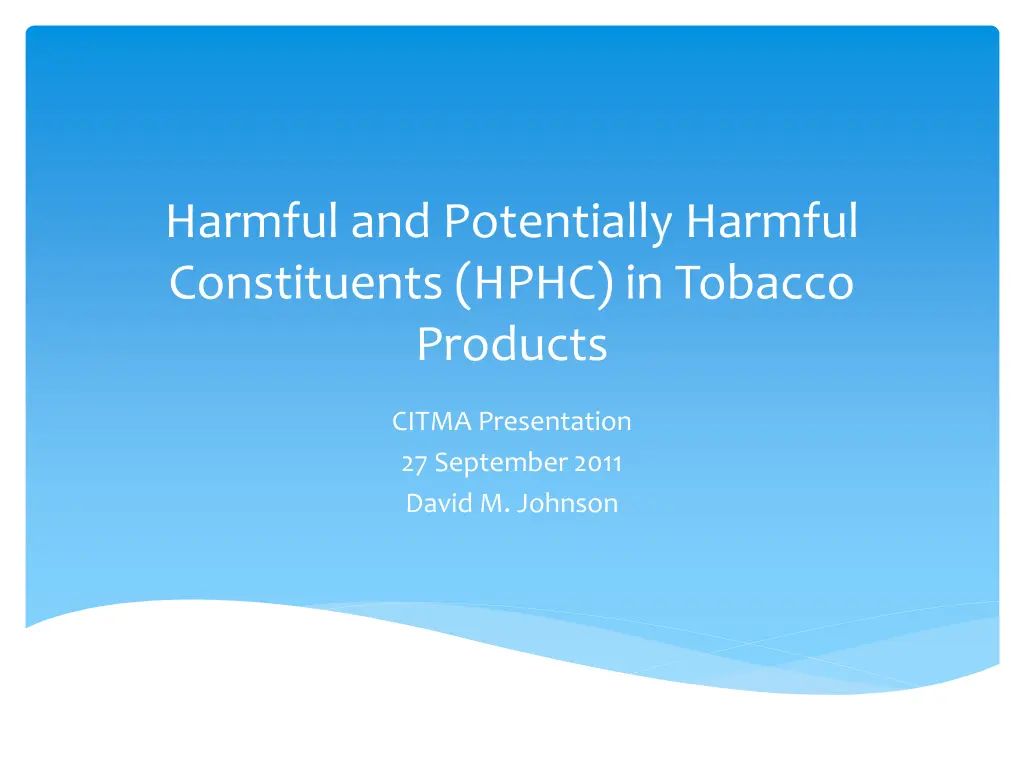
Understanding Harmful and Potentially Harmful Constituents in Tobacco Products
Explore the implications of Harmful and Potentially Harmful Constituents (HPHC) in tobacco products, as required by Section 904(e) of the FFDCA. Learn about the criteria for inclusion in the list, potential regulatory issues, and the importance of engagement to avoid excessive costs. Stay informed about toxic, carcinogenic, and addictive substances that may impact human health and regulatory actions.
Download Presentation

Please find below an Image/Link to download the presentation.
The content on the website is provided AS IS for your information and personal use only. It may not be sold, licensed, or shared on other websites without obtaining consent from the author. If you encounter any issues during the download, it is possible that the publisher has removed the file from their server.
You are allowed to download the files provided on this website for personal or commercial use, subject to the condition that they are used lawfully. All files are the property of their respective owners.
The content on the website is provided AS IS for your information and personal use only. It may not be sold, licensed, or shared on other websites without obtaining consent from the author.
E N D
Presentation Transcript
Harmful and Potentially Harmful Constituents (HPHC) in Tobacco Products CITMA Presentation 27 September 2011 David M. Johnson
HPHC in Tobacco Products HPHC list Section 904(e) of the FFDCA Implications of the list Testing and regulatory issues Costs to small manufacturers Potential reactions/responses to FDA List composition Burned versus unburned products Rationale for testing Costs to small manufacturers
HPHC in Tobacco Products Section 904(e) of FFDCA requires FDA to: Establish and periodically revise a list of harmful and potentially harmful constituents, including smoke constituents, that may threaten human health by brand and by quantity in each brand and subbrand.
HPHC in Tobacco Products The list includes potentially inhaled, ingested or absorbed species in tobacco products or tobacco smoke Implications for secondhand smoke Population based assessment The current constituents are generally deemed to be Toxic substances Carcinogens (IARC , EPA, NTP) Substances that enhance the addictive potential of the product, increase initiation, decrease or delay cessation, or increase the intensity of use Chemical substances that may increase the harm of a tobacco product constituent
HPHC in Tobacco Products The current list focused on constituents that are: Toxic Carcinogenic Addictive Other categories may be included at a later date There is the potential to influence the actions of the FDA This is vitally important to CITMA CITMA must be engaged in this process to avoid excessive and unnecessary costs
HPHC in Tobacco Products Criteria for inclusion in the list Likely, probable or possible human carcinogen (IARC, NTP, NIOSH) Identified adverse cardiac or respiratory effects (ATSDR or EPA) Identified reproductive or developmental toxins (CA EPA) Literature review shows evidence of indicators of abuse liability Items banned in food (for smokeless products) Currently 96* constituents listed The list will be reviewed and revised periodically Written comments due October 11, 2011
List of HPHC in Tobacco Products Constituent Inclusion Criteria* CA, RT, AD CA RT RT, CT CA CA, RT CA CA CA CA RT AD CA CA, CT, RDT CA CA, CT CA CA, CT, RDT CA, CT CA, CT CA CA CA CA Acetaldehyde Acetamide Acetone Acrolein Acrylamide Acrylonitrile Aflatoxin B1 4-aminobiphenyl 1-aminonaphthalene 2-aminonaphthalene Ammonia Anabasine o-Anisidine Arsenic A-a-C (2-Amino- 9H-pryido[2,3-b]indole Benz[a]anthracene Benz[j]anthracene Benzene Benzo[b]fluoranthene Benzo[k]fluoranthene Benzo[b]furan Benzo[a]pyrene Benzo[c]phenanthrene Beryllium *CA-carcinogen, RT - respiratory toxin, CT-cardiovascular toxin, RDT-reproductive or developmental toxin, AD - addictive
List of HPHC in Tobacco Products Constituent Inclusion Criteria* CA,RT,RDT CA,RT,RDT CA RDT CA CA, RDT CA, RT, RDT CA, CT CA, CT Banned in food CA, RT CA CA CA,CT CA CA CA CA CA CA CA CA CA, RDT CA CA,RT,RDT CA, RT CA 1,3-butadiene Cadmium Caffeic Acid Carbon monoxide Catechol Chlorinated dioxins/furans Chromium Chrysene Cobalt Coumarin Cresols (o-, m- and p-cresol) Crotonaldehyde Cyclopenta[c,d]pyrene Dibenz[a,h]acridine Dibenz[a,j]acridine Dibenz[a,h]anthracene Dibenzo[c,g]carbazole Dibenzo[a,e]pyrene Dibenzo[a,h]pyrene Dibenzo[a,i]pyrene Dibenzo[a,l]pyrene 2,6-dimethylaniline Ethyl carbamate (urethane) Ethylbenzene Ethylene oxide Formaldehyde Furan Glu - P - 1 (2-Amino-6-methyldipyrido[1,2-a:3',2'-d]imidazole) CA Glu - P - 2 (2-Aminodipyrido[1,2-a:3',2'-d]imidazole) Hydrazine CA CA, RT *CA-carcinogen, RT - respiratory toxin, CT-cardiovascular toxin, RDT-reproductive or developmental toxin, AD - addictive
List of HPHC in Tobacco Products Constituent Inclusion Criteria* RT, CT CA CA CA CA, CT, RDT CA CA, RDT RT CA CA CA, RT CA, RT RDT, AD CA, RDT, RT CA CA CA CA CA CA CA CA CA CA CA AD RT, CT CA CA Hydrogen cyanide Indeno[1,2,3-cd]pyrene IQ (2-Amino-3-methylimidazo[4,5-f]quinoline) Isoprene Lead MeA-a-C (2-Amino-3-methyl)-9H-pyrido[2.3-b]indole Mercury Methylethylketone 5-Methylchrysene 4-(Methylnitrosamino)-1-(3-pyridyl)-1-butanone (NNK) Naphthalene Nickel Nicotine Nitrobenzene Nitromethane 2-Nitropropane N-Nitrosodiethanolamine (NDELA) N-Nitrosodiethylamine N-Nitrosodimethylamine (NDMA) N-Nitrosomethylethylamine N-Nitrosomorpholine (NMOR) N-Nitrosonornicotine (NNN) N-Nitrosopiperidine (NPIP) N-Nitrosopyrollidine (NPYR) N-Nitrososarcosine (NSAR) Nornicotine Phenol PhIP (2-Amino-1-methyl-6-phenylimidazo[4,5-b]pyridine) Polonium-210 *CA-carcinogen, RT - respiratory toxin, CT-cardiovascular toxin, RDT-reproductive or developmental toxin, AD - addictive
List of HPHC in Tobacco Products Constituent Inclusion Criteria* RT, CT CA, RT CA RT CA CA RT, RDT CA CA CA, RT CA, RT CA, RT CA Propionaldehyde Propylene oxide Quinoline Selenium Styrene o-Toludine Toluene Trp- P-1 (3-Amino-1,4-dimethyl-5H-pyrido[4,3-b]indole) Trp- P-2 (1Methyl-3-Amino-5H-pyrido[4,3-b]indole) Uranium-235 Uranium-238 Vinyl acetate Vinyl chloride *CA-carcinogen, RT - respiratory toxin, CT-cardiovascular toxin, RDT-reproductive or developmental toxin, AD - addictive
Implications of the HPHC List Nominally the list is a standalone item However, Section 904(e) mandates that FDA Establish a list of tobacco and/or smoke constituents that may be harmful to human health Review and revise this list periodically Establish the quantities of these constituents by: Brand Subbrand
Implications of the HPHC List The existence of the list and its content are not relevant absent testing This list is a very small subset of the thousands of smoke chemicals Section 904(e) anticipates: Periodic testing by brand/subbrand Periodic reporting of constituents by brand/subbrand Significant costs if the FDA does not understand Which constituents should be tested Cost implications of testing Resource limitations (contract laboratories) Product standard implications
Implications of the HPHC List Product Standard Implications of HPHC List Regulation of constituent composition Metals are a direct result of geography and growing conditions for the tobacco PAHs are a result of incomplete combustion and are variable depending upon smoking conditions Need to define and validate smoking method Validation of analytical methods for constituents Robust method Variability known Environmental sources exist for many of the constituents
Implications of HPHC List Product Standard Implications of HPHC List Regulatory Threshold Levels Definition of No Observable Effect Level (NOEL) Inability to regulate levels due to the actions of the consumer Unintended consequences e.g. reduction of nicotine level in cigarettes Increasing quantity and/or intensity of smoking Ineffective and Burdensome requirements on the members of CITMA
Potential CITMA Responses to the HPHC List Question the composition of the list Appropriateness of including components that are at similar levels in other agricultural products, e.g. food, or in air Uptake from soil by any agricultural product grown on the soil under the given conditions (e.g. metals) Air levels of PAHs , metals, etc. Dietary intake levels Nutrients included on the list Selective editing of the data in support of inclusion Normal human metabolic byproducts from ethanol
Composition of the List Argument will be made by TPSAC that the route of exposure eliminates the food argument for metals This is patently incorrect Metals are present at significant levels in air from: Fossil fuel combustion processes Volcanic activity Smelting operations Dust Combustion of organic materials (e.g. coal, wood, oil products, etc.)
Example of metals in ambient air (Source: Great Lakes Regional Pollution Prevention Roundtable) Metal (mg/kg) Chromium 3.7 Source Lead 2 190000 146 (37-1504) Selenium 3 Arsenic 4.5 Agricultural Limestone Baghouse dust gray iron foundry Cement kiln dust (nonwaste burning) Coal anthracite bituminous lignite Gray iron foundry emissions Oil distillate Sewage sludge Soil Wood 27.2 (8-257) 8.5 (<0.001 - 121) 10.4 (2-159) 7 14 7 5000 - 170000 0.1 - 0.5 500 (13 - 26000) 19 (10-700) 20 54 (1 - 2000) 54 (1 - 2000) 5 (1.7 - 17.2) 0.39 (<0.1 - 4.3) 10 (1.1 - 230) 7.2 (<1 - 97)
Composition of the List Air exposure per day (micrograms) [US EPA 2009] cigarette contribution vs urban exposure (%) Per pack of cigarettes (micrograms) Metal Urban Rural 31.5 61.4 12.2 3.4 0.659 1.4602 0.697 0.2078 0.1024 2.09% 2.38% Lead Chromium Selenium Arsenic Nickel 10.5 11.4 3.4 2.2 1.98% 0.90%
Composition of the List PAHs, which are comprised of over 100 compounds including the benzopyrenes (e.g. BaP) are in the air as the result of incomplete combustion of organic materials such as Coal Vehicle exhaust (from oil, gasoline, diesel) Wood or other plant matter, including tobacco Sludge burning Et cetera Air concentrations ~2.8 ng/m3(0.1 9.4 ng/m3) [Colucci and Begeman, Environ. Sci. Technol., 1971, 5(2), 145-150] Food is main exposure source 97% of total daily intake (TDI) [Hattemer-Frey and Travis, Toxic. And Ind. Health, May 1991, 7(3), 141-157] Estimated TDI is 2.2 micrograms per day [ibid] ~7ng/cigarette (140ng per pack) for 2R4F
Composition of the List Acetaldehyde has been observed in ambient air at 32ppb in Los Angeles [US EPA Health Assessment Document for Acetaldehyde EPA/600/8-86-015A, 1987] Ubiquitous in the environment Sources include combustion of organic materials Vehicle exhausts Fireplaces Coal refining Is a human metabolic product in persons that consume alcohol Levels up to 20 ppb have been observed from the KY reference cigarette
Composition of the List Dietary Sources of many of the constituents are comparable to or higher than the levels in tobacco products Metals are similar in foodstuffs and tobacco PAHs are similar or higher in grilled or smoked foods Acetaldehyde is a normal component of fruits and vegetables Aflatoxins and nitrosamines are present in cereals and preserved meats, respectively
Composition of the List Arsenic occurrence Naturally occurs in soil Associated with igneous or sedimentary rock Natural weathering releases arsenic Volcanic activity introduces arsenic into the air Found at low levels in air, ground water, surface water, drinking water Arsenic found at 0.78 7.9 ng/g in 4200 tap water samples Finished drinking water in the Midwest contained up to 50 ng/g arsenic Found at varying levels in food (meat, grains, juices, vegetables) FDA has established MCLs for arsenic in food
Composition of the List Food Arsenic (ppm) 0.929 0.007 0.024 0.678 0.501 0.141 0.027 canned tuna dry table wine fried chicken shrimp fish sandwich on bun New England clam chowder granola with raisin Cigarete smoke (per cigarette)* Cigarete smoke (per pack) 0.01 0.2 *Sherer and Barkemeyer, Ecotox. And Environ. Safety, 1983, 7(1), 71-78
Composition of the List Cadmium occurs in the environment from Industrial processes Battery production Coatings and plating Alloy production Pigments Cadmium is a naturally occurring element in soil Naturally present in coal and other fossil fuels, phosphate rock, volcanic activity, and natural events, e.g. forest fires Cadmium has been detected in drinking water and in most foods. Plants bioaccumulate cadmium (predominantly in the leaves) Higher levels found in leafy vegetables (e.g. lettuce, cabbage) Meat Fruits, vegetables, and grains
Composition of the List Lead occurs in the environment from Lead-acid storage battery production and recycling Ammunition Bronze and brass products (production and recycling) Naturally occurs in the soil Introduced into the air by Volcanic activity Natural weathering Lead is found in most environmental media Ambient air Water (ground water, drinking water, and surface water) Soil sediment and dust food
Composition of the List Food Lead (ppm) 0.003 0.004 0.013 0.011 0.017 0.019 0.015 0.033 0.66 white bread apple juice spinach collards honey shrimp sweet potato Cigarete smoke (per cigarette)* Cigarete smoke (per pack) *Sherer and Barkemeyer, Ecotox. And Environ. Safety, 1983, 7(1), 71-78
Nutrients included on HPHC List Many metals are essential micronutrients for humans Iron Hemoglobin oxygen transport Copper Cofactor for enzymes Deficiency implicated in coronary disease Chromium Chromium III is a micronutrient required for proper blood sugar control Chromium VI is a carcinogen -> speciation of chromium is an important consideration Zinc Cofactor for enzymes Neural signalling Selenium Catalyst for production of thyroid hormone Protein component Role in proper immune function Nickel Cofactor for enzymes
Selective Editing of Data Caffeic Acid Hirose article feeds animals 1- 2% caffeic acid in the diet and finds cancer of the forestomach The NOEL appears to be 0.5% in the diet Caffeic acid is an antioxidant Inhibition of oxidati0n of LDL At concentrations below 0.5% caffeic acid has anticancer activity Protective effect of caffeic acid phenyl ester Has been noted to reduce the effect of BaP Widely found in fruits, vegetables, citrus fruit The hydrocinnamic acids, of which caffeic acid is one, are not tumor promoting at reasonably high levels (0.5%=5000ppm)
Caffeic Acid Content of Food Caffeic Acid Content (ppm) 85 - 1270 977 19 85 631 330 160 - 900 250 550* Foodstuff Apples Blueberries Broccoli Carrots, orange Coffee Eggplant Lettuce Tea Tobacco *Li et al, Chromatographia, 69 (7-8);743-748
Acetaldehyde a Curious Case Acetaldehyde is present in many fruits (ripe) Is a component of vehicle exhaust Found at 2.94 g/m3in urban areas and 3.37 g/m3in rural areas [US EPA Air Toxics Data] This corresponds to 29 34 g of exposure per day from air Is a product of coal refining Is recognized by the FDA as a GRAS component for use in food [21 CFR 182.60] as a flavor Is a normal human metabolite of ethanol
Rationale for Testing The actual exposure to any constituent is a function of Elution from or passage through the filter material for cigarettes Extraction of the constituent from the tobacco matrix for smokeless tobacco in vivo Whole tobacco analysis creates a deceptive view of the actual exposure of the user
Rationale for Testing Testing should be minimal as many components of tobacco smoke can be estimated from basic smoke data References: M.E. Counts, F. S. Hsu, S. W. Laffoon, R. W. Dyer, and R. H. Cox, Regul. Toxicol and Pharmacol., 2004, Apr; 39(2):111-134 T. Hyodo, Y. Maruta, H. Itaya, A. Makita, T. Kodera, M. Meger, Regul. Toxicol. And Pharmacol., 2007, Jul; 48(2):194-224 P. D. Case and N. D. Warren, Patent Number WO/2004/042635, Publication Date May 21, 2004
Rationale for Testing Estimation of the constituent concentration, given demonstrated performance, to show improving trends over time is a valid as very precise and highly variable data More cost effective Allows more data points for averaging reducing the standard deviation Predicated on robust relationship in the estimation process Meets FDA goal of demonstrating reductions in harm caused by cigarettes over time
Rationale for Testing A smoking method that has undergone rigorous interlaboratory validation is required to perform smoke constituent analysis Method variation must be known Instrumental differences Operator differences Normal variation in the product must be known The method must be able to be reproduced by any competent analyst to obtain reliable data
Rationale for Testing The cost to benefit ratio of the testing must be considered Cost of testing is very high Estimated cost of Hoffman analyte testing at Labstat in Canada is ~$12000 per sample This only accounts for approximately half of the HPHC List Large manufacturers have the internal resources to perform these analyses in-house CITMA would have to use contractors and the resources are limited High cost and low availability Using the data to mandate selective reductions Will not necessarily result in reduced risk/harm Time required to verify the benefit of reductions is long Years for pulmonary endpoints Decades for cancer
Summary The HPHC List should be evaluated in light of nontobacco sources of constituents Source and ability to control the constituent should be a factor Air should be used for comparison to smoked products Food and water should be used for smokeless product comparisons The NOEL should be considered in establishing regulatory thresholds Testing should be minimized Testing should be limited to only those items that are needed For estimation of other parameters Where added precision is absolutely required To address cost and analytical capacity issues for small manufacturers Should only be done to support regulatory action that will result in a definitive health benefit
Recommendations CITMA should Recognize that the list will not change Pursue the complete evaluation of the list composition to impact regulatory and testing consequences of the list Submit comments to FDA by the 11 October 2011 deadline Address the inherent testing issue Build case for the financial burden associated with excessive testing Limited internal resources Limited contract laboratory capacity Cost as a portion of gross revenue Address the issue of demanding unjustified precision in the data (cost/benefit)






















